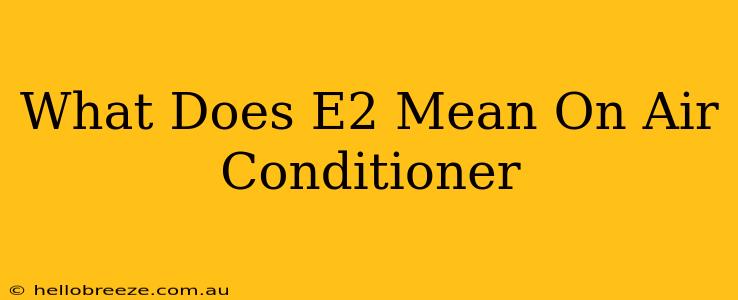Seeing an error code like "E2" flash on your air conditioner's display can be frustrating. This guide will help you understand what the E2 error code typically signifies and what steps you can take to resolve the issue. Understanding your air conditioner's error codes is crucial for maintaining efficient and reliable cooling throughout the summer months.
Deciphering the E2 Error Code
The meaning of the "E2" error code can vary slightly depending on the brand and model of your air conditioner. However, in most cases, E2 indicates a problem with the outdoor unit's communication with the indoor unit. This means there's a breakdown in the signal exchange between the two essential components of your system. This communication is vital for proper operation, as the indoor and outdoor units work together to cool your space.
Common Causes of the E2 Error
Several factors can disrupt this crucial communication and trigger the E2 error:
- Wiring Problems: Loose, damaged, or corroded wiring between the indoor and outdoor units is a primary culprit. Even a small break in the connection can prevent the units from communicating effectively.
- Faulty Control Board: The control board acts as the "brain" of your AC system. A malfunctioning control board in either the indoor or outdoor unit can lead to communication errors.
- Sensor Issues: Various sensors monitor different aspects of the system's operation. A faulty temperature sensor or other sensor can disrupt communication and trigger the E2 code.
- Refrigerant Leaks: While less direct, a significant refrigerant leak can sometimes indirectly affect communication between the units, resulting in the E2 error.
- Power Supply Issues: Intermittent power surges or low voltage can affect the communication signals.
Troubleshooting the E2 Error
Before calling a professional HVAC technician, try these basic troubleshooting steps:
-
Check the Power Supply: Ensure that the power cords for both the indoor and outdoor units are securely connected and that you have power to the outlets. A tripped breaker or blown fuse can disrupt the system's operation.
-
Inspect the Wiring: Carefully examine all the wiring connections between the indoor and outdoor units. Look for any signs of damage, corrosion, or loose connections. Caution: Before handling any wiring, turn off the power to the system.
-
Check the Air Conditioner's Circuit Breaker: Locate the circuit breaker controlling your air conditioner and ensure it's not tripped. Reset the breaker if needed.
-
Reset the System: Some air conditioners can be reset by simply turning them off completely (at the breaker), waiting a few minutes, and then turning them back on.
When to Call a Professional
If the above troubleshooting steps fail to resolve the E2 error, it's crucial to contact a qualified HVAC technician. Attempting to repair more complex issues yourself can be dangerous and could further damage your air conditioner. A professional has the expertise and tools to accurately diagnose the problem and perform the necessary repairs, ensuring your system's safety and efficiency.
Keywords: E2 error code, air conditioner error, AC troubleshooting, HVAC repair, air conditioner problems, communication error, outdoor unit, indoor unit, wiring problems, control board, sensor issues, refrigerant leaks, power supply, troubleshooting steps.

